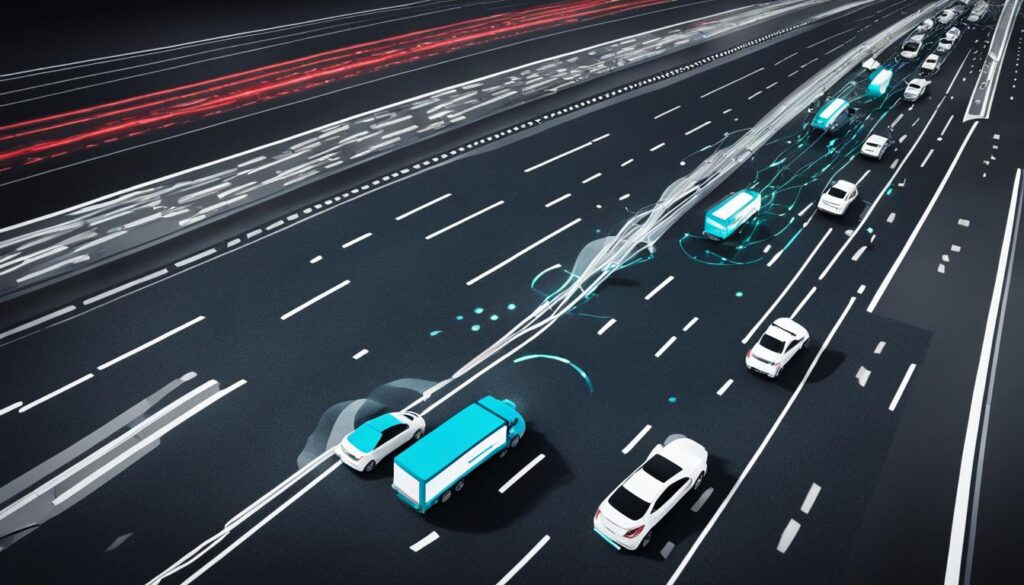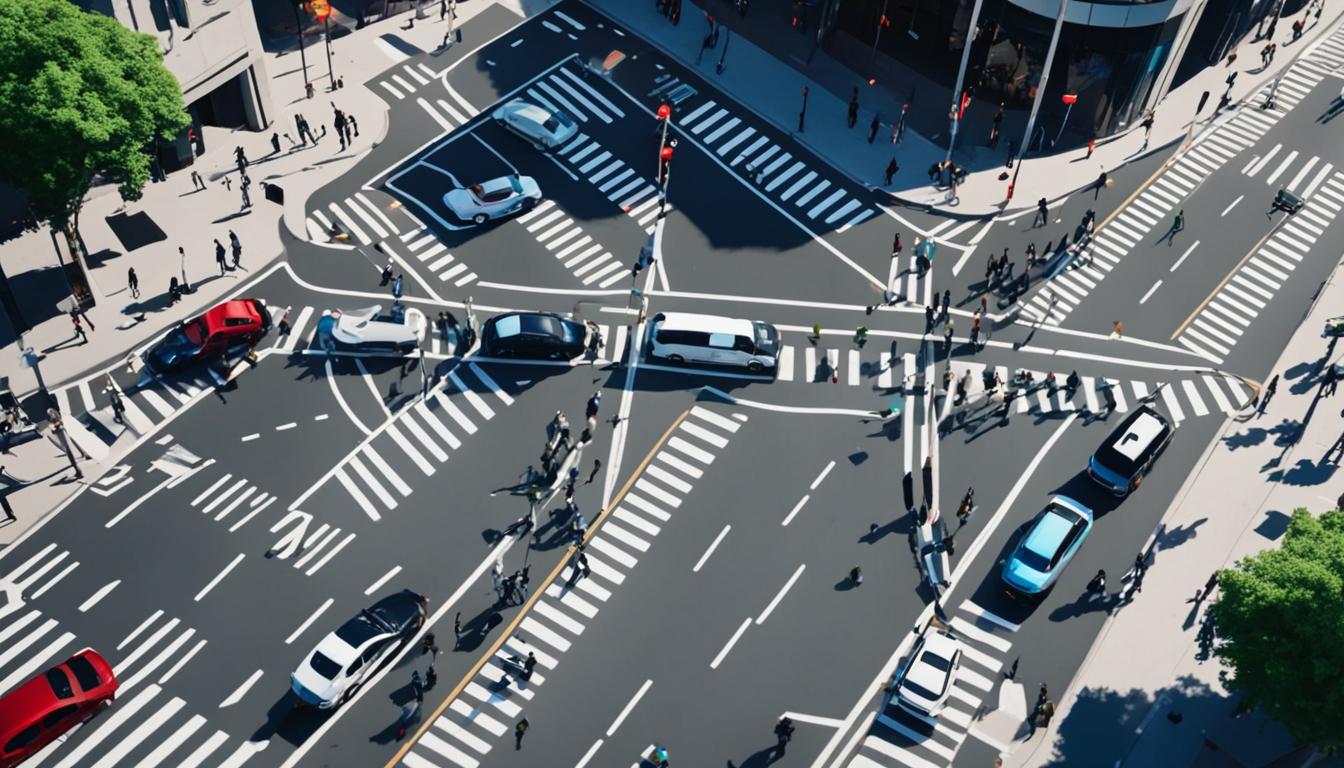Artificial intelligence (AI) is transforming the transportation industry, playing a crucial role in predicting and preventing traffic accidents. Through innovative applications and technologies, AI is making transportation safer and more efficient.
Companies like UVeye, Geotab, and Yunex Traffic are harnessing the power of AI to enhance vehicle inspection, fleet management, and intelligent traffic management systems. Additionally, AI is being utilized in assisted driving technologies by renowned companies like Tesla, Waymo, and Mobileye.
By leveraging AI algorithms, real-time data analysis, and advanced driver-assistance systems, AI can help predict and prevent traffic accidents, ultimately improving road safety for everyone.
Contents
- 1 AI-Powered Vehicle Inspection Systems
- 2 Fleet Integration and Management with AI
- 3 Intelligent Traffic Management Systems
- 4 Assisted Driving Technologies
- 5 Conclusion
- 6 FAQ
- 6.1 Can artificial intelligence help predict and prevent traffic accidents?
- 6.2 How is AI used in vehicle inspection?
- 6.3 What is the role of AI in fleet integration and management?
- 6.4 How does AI contribute to intelligent traffic management?
- 6.5 How does AI assist in preventing accidents in driving?
- 6.6 What is the impact of AI on traffic accident prevention?
- 7 Source Links
Key Takeaways:
- AI is revolutionizing the transportation industry by predicting and preventing traffic accidents.
- UVeye, Geotab, and Yunex Traffic are among the companies utilizing AI for vehicle inspection, fleet management, and intelligent traffic management.
- Tesla, Waymo, and Mobileye are incorporating AI into assisted driving technologies to enhance driver safety.
- By leveraging AI algorithms and real-time data analysis, AI can help create a safer and more efficient transportation environment.
- AI’s role in reducing traffic accidents continues to evolve, with the potential for even greater impact in the future.
AI-Powered Vehicle Inspection Systems
Traditional vehicle inspection processes have been labor-intensive and prone to human error. However, with the integration of AI-powered inspection systems, vehicles can now undergo automated inspections that are both fast and accurate. Companies like UVeye and Tractable are utilizing AI algorithms and computer vision technology to scan vehicles, assess their condition, and generate comprehensive reports that identify any defects or damages.
This innovative approach to vehicle inspections not only improves the accuracy of assessments but also plays a pivotal role in preventing accidents. By leveraging AI for inspections, transportation companies can detect potential issues early on, reducing the risk of accidents caused by faulty brakes, worn-out tires, or other mechanical defects.
With AI-powered vehicle inspection systems, transportation companies can enhance vehicle safety, ensuring that their fleets are in optimum condition and minimizing the likelihood of accidents on the road.
Advantages of AI-Powered Vehicle Inspection Systems:
| Advantages | Description |
|---|---|
| Quick and accurate inspections | AI algorithms and computer vision technology allow for efficient and precise vehicle assessments. |
| Early detection of defects | AI-powered systems can identify potential issues before they escalate, preventing accidents caused by mechanical failures. |
| Comprehensive condition reports | AI-generated reports provide detailed information on the vehicle’s condition, helping transportation companies address maintenance needs promptly. |
| Improved overall vehicle safety | By utilizing AI for inspections, transportation companies can proactively address maintenance issues, reducing the risk of accidents on the road. |
Fleet Integration and Management with AI
AI is revolutionizing fleet integration and management, providing transportation companies with advanced solutions to optimize performance and enhance driver safety. Industry leaders like Geotab and Azuga are harnessing the power of AI to streamline operations, reduce accidents, and improve overall efficiency.
AI-Powered Fleet Management Solutions
Geotab offers an AI-powered fleet management solution that enables companies to monitor and optimize their fleets in real-time. With advanced analytics and predictive algorithms, Geotab’s system can identify critical engine issues, detect tire problems, and alert fleet managers about engine fault codes. By proactively addressing these issues, transportation companies can significantly reduce the risk of breakdowns and accidents, ensuring the safety of both their drivers and the public.
The table below showcases the key features of Geotab’s AI-powered fleet management solution:
| Features | Description |
|---|---|
| Real-time vehicle monitoring | Constantly tracks vehicles’ performance, location, and condition for enhanced control and oversight. |
| Diagnostic alerts | Instantly notifies fleet managers about critical engine issues, tire problems, and engine fault codes, ensuring proactive maintenance and risk reduction. |
| Optimized routing | Uses AI algorithms to optimize fleet routes, reducing fuel consumption and improving overall efficiency. |
| Driver behavior monitoring | Monitors driver behavior, providing insights on speeding, harsh braking, and other risky driving patterns to promote safer habits and reduce accidents. |
AI-Based Driver Behavior Monitoring
Azuga is another industry leader leveraging AI for driver behavior monitoring, significantly enhancing safety on the road. Azuga’s AI-based system provides real-time feedback and coaching to drivers, fostering safer habits and reducing the likelihood of accidents. The system tracks various parameters, including speeding, harsh braking, and rapid acceleration, and offers personalized feedback to drivers, enabling them to improve their driving skills and reduce risks.
By incorporating AI technology into fleet management, transportation companies can optimize routes, reduce fuel consumption, identify potential issues before they lead to accidents or breakdowns, and create a safer driving environment for their drivers.

Intelligent Traffic Management Systems
Artificial intelligence (AI) is transforming traffic management through the implementation of intelligent traffic management systems (ITMS). Leading companies like Yunex Traffic are utilizing AI to monitor real-time traffic conditions, predict congestion, and optimize traffic flow seamlessly. By leveraging AI algorithms and real-time data analysis, ITMS enables more efficient traffic management, thereby reducing the risk of accidents and enhancing overall traffic safety.
One notable application of AI in traffic management is the capability to detect and prevent accidents caused by wrong-way drivers. For instance, Yunex’s ITMS can swiftly identify instances of vehicles traveling in the wrong direction and promptly activate warning signs or traffic signals to mitigate potential collisions. This proactive approach significantly contributes to preventing accidents and ensuring safer and smoother traffic flow on the roads.
Benefits of AI in Traffic Management
- Real-time Traffic Monitoring: The integration of AI allows for accurate real-time traffic monitoring, enabling faster response to congestion, accidents, and other road incidents.
- Traffic Congestion Prediction: AI-powered ITMS analyze historical and real-time data to predict traffic congestion patterns, facilitating proactive measures to alleviate bottlenecks and minimize the chances of accidents.
- Optimized Traffic Flow: By employing AI algorithms, traffic management systems can optimize traffic signal timings, lane assignments, and route planning, leading to more efficient traffic flow and improved safety.
With the advent of AI, cities and transportation authorities can revolutionize traffic management and significantly reduce the occurrence of accidents caused by traffic congestion. By leveraging real-time monitoring, congestion prediction, and proactive accident prevention measures, AI-driven ITMS are playing a pivotal role in creating safer and more efficient roads for commuters.

| Benefits of AI in Traffic Management | AI Applications in Traffic Management |
|---|---|
|
|
Assisted Driving Technologies
AI is revolutionizing the automotive industry with its role in developing advanced driver-assistance systems (ADAS). These AI-powered technologies enhance driver safety and play a crucial role in preventing accidents on the road.
One prominent company harnessing the power of AI for assisted driving is Tesla. Tesla’s Autopilot system, equipped with AI algorithms and sensors, detects surrounding vehicles and obstacles, providing lane departure warnings and automatic emergency braking. This AI-powered driving assistance system significantly reduces the risk of accidents caused by human error or distractions.

Another industry leader in AI-assisted driving is Waymo. Waymo’s self-driving technology relies on AI to analyze complex traffic scenarios and make informed decisions, ensuring the safety of passengers and other drivers. By leveraging AI, Waymo is making significant strides in preventing accidents and revolutionizing the future of transportation.
Mobileye is yet another company at the forefront of AI-powered driving assistance. Their advanced driver-assistance system (ADAS) uses AI to detect pedestrians, cyclists, and other vehicles, warning the driver of potential hazards and preventing collisions. Mobileye’s commitment to incorporating AI in driving assistance technology contributes to a safer driving experience for all.
With AI-assisted driving technologies like these, the future of transportation is becoming safer. These systems not only enhance driver safety but also prevent accidents by leveraging the power of AI algorithms and real-time data analysis.
Conclusion
Artificial intelligence (AI) is revolutionizing the transportation industry by significantly impacting road safety. Through applications such as AI-powered vehicle inspection systems, fleet integration and management, intelligent traffic management systems, and assisted driving technologies, the potential for predicting and preventing traffic accidents has greatly increased.
By utilizing AI algorithms and real-time data analysis, transportation companies and authorities can create a safer and more efficient environment for drivers and passengers. AI-powered vehicle inspection systems, such as those developed by UVeye and Tractable, enable quick and accurate detection of defects or damages that could lead to accidents. Fleet integration and management solutions powered by AI, like Geotab and Azuga, optimize vehicle conditions, routes, and driver behavior to reduce the risk of breakdowns and accidents. Intelligent traffic management systems, exemplified by Yunex Traffic, use real-time data to predict and prevent traffic congestion and accidents. Additionally, assisted driving technologies like Tesla’s Autopilot system, Waymo’s self-driving technology, and Mobileye’s advanced driver-assistance system (ADAS) enhance driver safety and prevent accidents on the road.
As AI technology continues to advance, the future of AI in transportation safety looks promising. Further developments in AI algorithms, enhanced data analysis capabilities, and the integration of AI in various transportation applications will contribute to a significant reduction in traffic accidents. The impact of AI on road safety will continue to improve, creating a safer and more efficient transportation system for everyone.
FAQ
Can artificial intelligence help predict and prevent traffic accidents?
Yes, artificial intelligence (AI) is playing a significant role in predicting and preventing traffic accidents. Through applications such as vehicle inspection, fleet integration, intelligent traffic management systems, and assisted driving technologies, AI is making transportation safer and more efficient.
How is AI used in vehicle inspection?
AI-powered vehicle inspection systems, like those developed by companies such as UVeye and Tractable, use AI algorithms and computer vision technology to quickly and accurately scan vehicles and provide comprehensive reports on their condition. This helps to identify defects or damages that could lead to accidents and enhance overall vehicle safety.
What is the role of AI in fleet integration and management?
AI is utilized in fleet management to monitor and optimize fleet performance, driver behavior, and routes. Companies like Geotab and Azuga use AI to detect engine issues, tire problems, and driver faults, reducing the risk of breakdowns and accidents. The AI-based driver behavior monitoring system also provides real-time feedback to drivers, improving safety and preventing accidents.
How does AI contribute to intelligent traffic management?
AI is used in intelligent traffic management systems (ITMS) to monitor traffic conditions, predict congestion, and optimize traffic flow in real-time. Companies like Yunex Traffic utilize AI algorithms and real-time data analysis to prevent accidents caused by traffic congestion and ensure safer and smoother traffic flow.
How does AI assist in preventing accidents in driving?
AI is integrated into assisted driving technologies developed by companies like Tesla, Waymo, and Mobileye. These technologies use AI algorithms and sensors to enhance driver safety by detecting surrounding vehicles, obstacles, and potential hazards. By providing warnings and automated emergency braking, AI-assisted driving systems greatly reduce accidents caused by human error or distractions.
What is the impact of AI on traffic accident prevention?
AI is revolutionizing the transportation industry and significantly impacting road safety. Through various applications, AI helps predict and prevent traffic accidents by improving vehicle inspection accuracy, optimizing fleet management, enhancing traffic management, and providing assistance to drivers. The continued advancement of AI technology holds great potential for further reducing traffic accidents and improving overall transportation safety.
Source Links
- https://www.forbes.com/sites/forbestechcouncil/2023/05/12/how-ai-is-helping-to-improve-transportation-safety-on-a-global-scale/?sh=240954aa5436
- https://labworksusa.com/a-revolutionary-breakthrough-using-ai-to-reduce-truck-accidents-on-the-road
- https://www.fleetowner.com/safety/article/21275998/reliable-ai-leads-to-realtime-visibility-and-instant-accident-prevention




